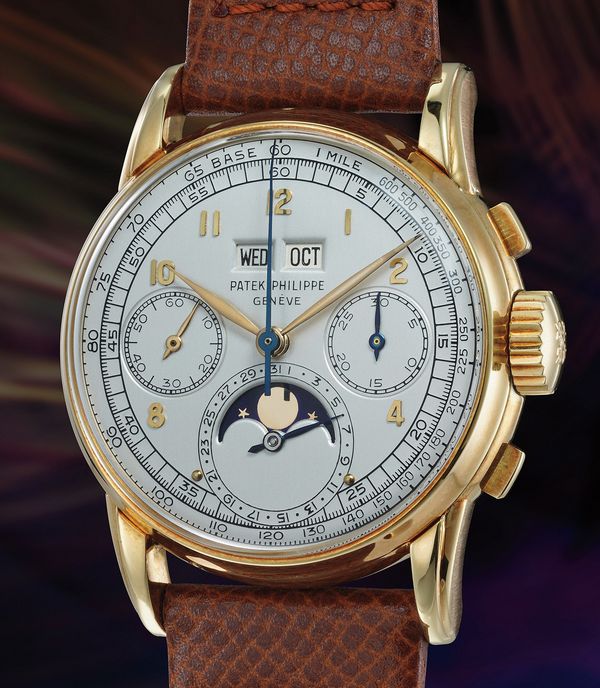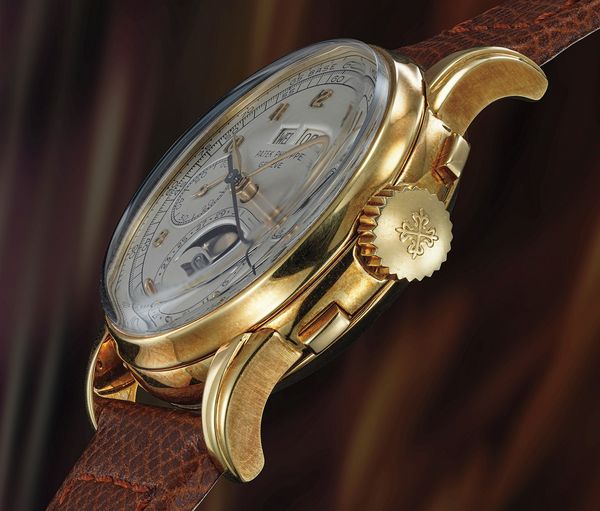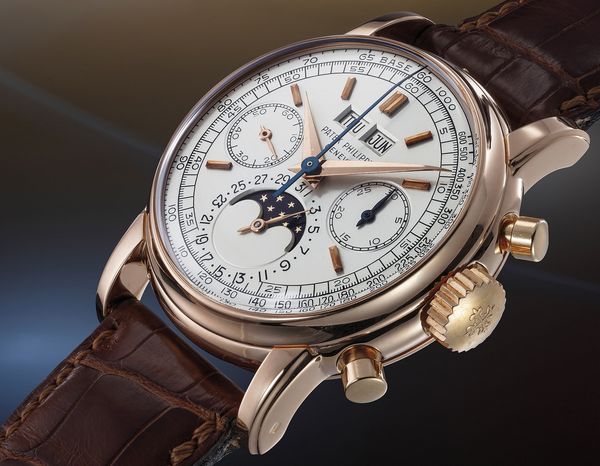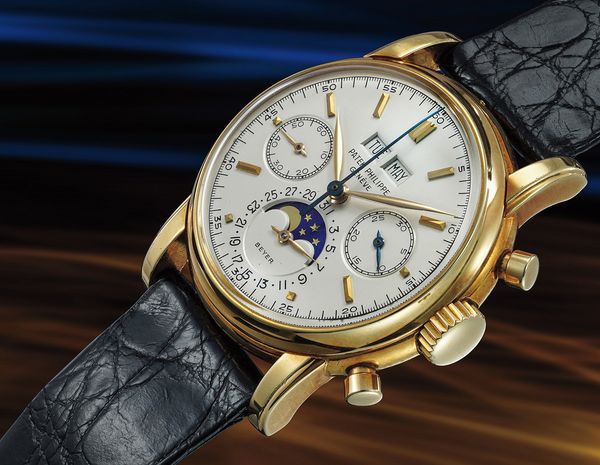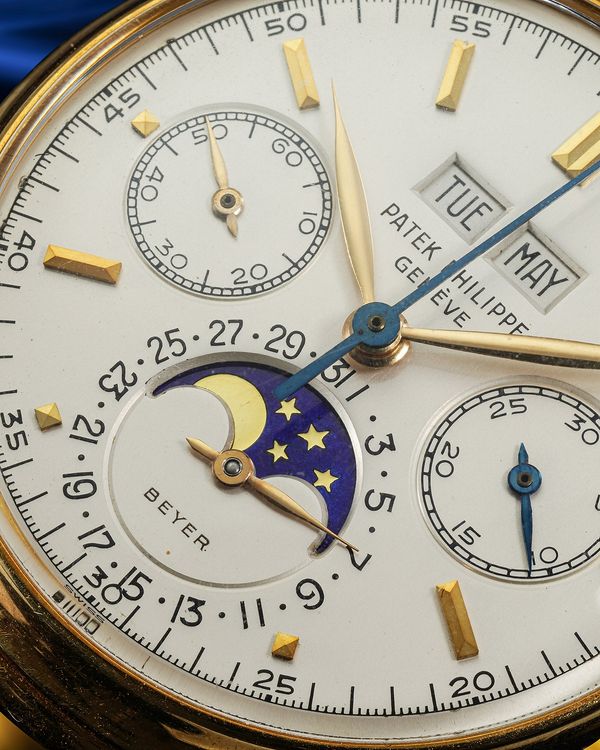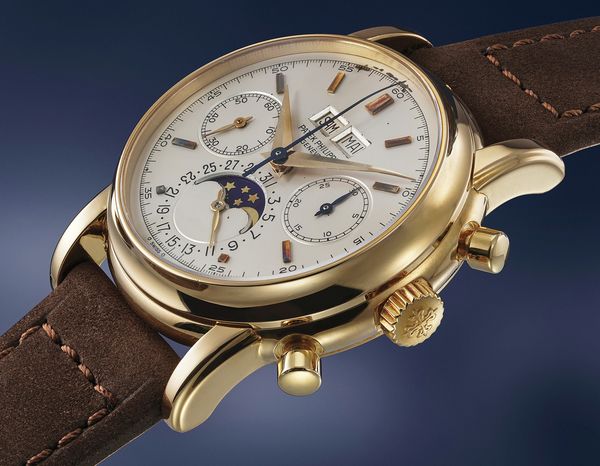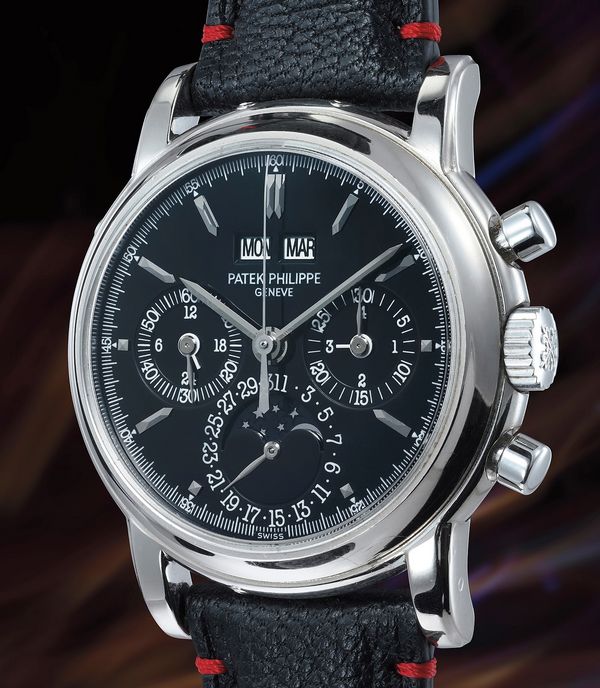Our first live auction of the fall 2023 season, the PHILLIPS Geneva Watch Auction: XVIII, takes place on November 3 and 4, at La Réserve Genève. The auction includes more than 180 of the world's finest watches – and though we are loath to boast, we truly think it's one of the best catalogs we've ever put together. We'll be highlighting a number of the most interesting lots and stories featured in the sale over the next month, including three of the Patek Philippe Perpetual Calendar Chronographs featured in this story.
- By Arthur Touchot
Even the best dinner parties now begin with guests checking the strength of their wifi signal or scrambling to find their headphones while faces, familiar or not, pop onto a screen. For better or worse, one of the biggest casualties of this new ritual has been the awkward dance one would perform around the dinner table to find one’s seat and direct interlocutor for the remainder of the evening.
Being quite shy, it’s a moment I used to dread as I am either kindly and strategically placed next to another watch enthusiast and soon relieved of the pressure to make conversation, or someone with absolutely no interest in my admittedly very niche hobby, in which case I’m in more trouble.
I suspect these evenings turned into warnings to never ask me an open-ended watch question such as: how do you explain the sudden popularity of vintage watches? Or why is Patek Philippe regardedby many as the finest watchmaker?
There are no easy answers to these questions – or rather, I wouldn’t know how to respond without launching into an impassioned speech and risking my reputation as a fun dinner guest. A shorter, failsafe way to present the case before making your table companion regret his or her question, would have been to point to one watch in particular – the Patek Philippe ref. 2499 – a watch that sadly I’ve never found myself wearing at a dinner party. Very few people in the world enjoy such a luxury.
The ref. 2499 is a perpetual calendar chronograph wristwatch – one of the world’s most complicated watches. It’s not the first, nor the last of its kind. Rather, it is considered to be the most beautiful, and as such holds a special place in the hearts of watch collectors, which I have been told the Ferrari 250 SWB fills for car enthusiasts.
The ref. 2499’s predecessor, the Patek Philippe ref. 1518, is arguably the more historically important of the two as it sits at the top the family tree, but the ref. 2499 is seen as many as a watch that successfully built on the merits of the first by retaining the core design signature of the original and presenting it in a larger and more contemporary case.
But even Patek thought the ref. 2499 could still be improved and over the course of a 35-year period, the company continued to modernise the model, creating four separate but almost identical models collectors refer to as ‘series’. I warned you watch enthusiasts enjoyed a long story. Well, this is the part in which we look at the four different models, three of which are included in the upcoming PHILLIPS Geneva Watch Auction: XVII, on May 13 and 14, 2023.
A Brief History
But first, let’s quickly look at the watch that comes before the ref. 2499. Introduced in 1941, the ground-breaking Patek Philippe ref. 1518 was the first wristwatch powered by a serially produced perpetual calendar chronograph movement – an incredible achievement given the diminutive size of the watch’s case.
Only pocket watches and a handful of wristwatches made upon special request were able to display this amount of information at once. Never before had a watchmaker found a way to miniaturise such an intricate movement at scale, and none were trying to deliver the answer during the middle of a world war.
Patek would only make 281 models during a 14-year production run (give or take), most of them in yellow gold, with a small percentage of the movements going into pink gold cases, and only a handful going into stainless steel ones.
Because Patek Philippe, and other high-end watch manufacturers preferred working with precious metal at the time, these extremely rare pieces are now the most coveted, and the reason why a stainless steel Ref. 1518 currently holds the record for the highest price achieved by a vintage Patek Philippe – the watch sold by Phillips for a cool £8.9m in 2016, and many speculate it would achieve a whole lot more today.
Even before the ref. 1518 was fully replaced, Patek Philippe introduced a successful sequel in the ref. 2499. Starting around 1951, Patek Philippe would produce 349 examples during a 35-year production run. While the new wristwatch retained many of the design codes established by the ref. 1518, it also introduced a new, contemporary case design, inspired by the industrial aesthetic of the 1950s.
The larger case and down-turned stepped lugs presented a stylistic change and made the new reference one of the most exciting watches to leave the Patek Philippe ateliers, officially launching one of the greatest family trees in the Swiss watchmaking industry. The production of perpetual calendar chronograph wristwatches has been uninterrupted and led to even more complicated wristwatches today.
Lot 186: A 1951 Patek Philippe Perpetual Calendar Chronograph Ref. 2499, First Series, In 18K Yellow Gold With 'Vichet' Case
Let’s begin with the first series ref. 2499, perhaps the most recognizable of the four models because it is the only one that features square chronograph buttons and applied Arabic numerals – two design features present in the watch’s predecessor, they’re a clear visual link between the ref. 1518 and the ref. 2499.
For this reason – along with its incredible rarity – the first series is arguably the most sought-after of the four. Patek Philippe only made this version of the watch for about half a decade, starting in 1951, and while exact production numbers remain unconfirmed, it’s a watch that only very rarely shows up in auction catalogues.
Two case makers have been employed for the case production. Consequently, first series cases present subtle differences according to the maker that produced them. The earliest examples – such as the above pictured piece from our upcoming Geneva auction – feature a Vichet case, defined by its flat caseback and the more “claw-shaped” and downturned lugs. Later examples are made by Wenger, who will make nearly all of the cases for the rest of the 2499 production until 1985. Those cases feature a slightly larger diameter, less markedly downturned lugs, and a bombé caseback.
Dial-wise, the first series features the same design as reference 1518. Some elements of these early first series dials present a variation: the date ring can be enclosed by boundaries (identical to parent reference 1518) or present no such delimitation, and the numerals can be Arabic or baton. As their ancestor ref. 1518, first series dials present a tachymeter scale and railway minute divisions combined with Arabic five-minute and baton fifth-of-a-second divisions. In fact, the earliest dial design found on 2499 – and exemplified by the present watch – features a closed date ring and Arabic numerals, making it a perfect copycat of a reference 1518 dial.
The scarcest of all series, it was in production only less than a decade, in the 1950s – though Vichet cases are not seen after 1953.
The example in our Geneva sale (lot 186) backs its importance as a model with absolutely unrestored and highly attractive condition. The case is in noteworthy condition, displaying crisp fluting to the lugs – so defining for this reference, but also so sensitive to polishing – and sporting an extremely crisp hallmark behind the upper left lug, along with another one protected by the caseback.
As an even nicer touch, the caseback still retains the Patek Philippe service sticker, which was affixed when the timepiece went back to the manufacture for service. The dial displays crisp engraved/enameled graphics with the sensitive accent in “Genève” intact. The light, even and enormously charming ivory patina grants the piece great warmth and an ineffable vintage appearance.
Most interestingly, this timepiece has been known on the market for three and a half decades, having spent its life in two of the world's most distinguished and leading Patek Philippe collections. The timepiece went back to the Patek Philippe factory for service in the late 1990s, where it received the service sticker on the caseback. Since then, it has seen hardly any, if any at all, wear on the wrist.
A Patek Philippe Perpetual Calendar Chronograph Ref. 2499, Second Series
The second series is the first ref. 2499 to feature round chronograph pushers, for example, as well as a slightly improved case designed to better protect the watch’s delicate movement from dust and humidity.
Another distinctive feature of the second series is the dial, which began featuring either Arabic numerals or baton numerals, but this was only the beginning of more significant changes. After only a short production run similar to the first series, production on the second series ceased around the early 1960s.
So rarified is the output of pink gold Second Series ref. 2499, that the eight identified pieces are all regarded as a "Mona Lisa" of watch collecting, their last appearances being as follows:
- 868’226 - last appeared at auction in 2013
- 868’605 - last appeared at auction in 1999
- 868’606 - the present watch, from an European collection
- 868’609 - former property of Eric Clapton, last appeared on the market in 2022
- 868’611 - last appeared at auction in 2001
- 868’613 - last appeared at auction in 2011
- 868’626 - last appeared at auction in 1989
- 868’752 - originally discovered in Italy and sold at auction in 2009
Further, when analysing where these pieces are today, it springs to mind that they are all in the world’s greatest private watch collections and quite equally spread between Asian, European and American collectors, underlining the truly worldwide appeal of these masterpieces.
Lot 11: A 1967 Patek Philippe Perpetual Calendar Chronograph ref. 2499, third series in 18k yellow gold, with Beyer retailer signature.
The tachymeter scale is one of the core features of the ref. 1518 and ref. 2499, but it disappeared with the arrival of the third series ref. 2499. This instead introduces a more open dial design with outer seconds divisions. The third series also waves goodbye to Arabic numeral dials, which were forever replaced in this model by baton numerals.
Early examples of the third series stand out as having full hard enamel dials, a feature that began fading out in the late 1960s. Throughout its rather longer production run, which spanned almost 20 years encompassing the 1960s and 1970s, the third series otherwise stays unchanged.
Retailed and signed by Beyer, the third-series example included in the Geneva Watch Auction: XVIII is one of only four third-series 2499s to feature a Beyer retailer signature – no Beyer examples are known from the first or second series. As an added bonus, and further confirmation of its provenance, the Beyer code “216707+Z3” is minutely hand-engraved below the “Swiss” designation to the inside of the caseback.
The condition of the timepiece is as astounding as its rarity. The dial is absolutely clean and fresh, and features an engraved/enameled dial. This costly technique was abandoned for financial reasons at the beginning of the 1970s, thus only a few early third series examples bear such never-again-seen dials. The case is also remarkably well-preserved, fully retaining its proportions and peculiar architecture, sporting a lightly tarnished layer that amplifys the vintage charm. Even the hallmark at six o'clock – a notoriously sensitive position for hallmarks as they are easily rubbed off by the friction with the bracelet especially in gold watches – is present and only slightly faded, indicating very little use in the entire life of the watch.
The history of this watch complements and boosts its rarity and condition. It has appeared only once before at auction – at Phillips Geneva in November 2002 – and it spent the past 21 years in one of the most important vintage Patek Philippe collections in the world.
The Patek Philippe Perpetual Calendar Chronograph Ref. 2499, Fourth Series
Known on paper as the ref. 2499/100, the fourth and final series of the ref. 2499 looks almost exactly like the third as it also features round chronograph pushers, applied baton numerals, and outer seconds divisions, but for the very first time in the series, the dial is covered by flat sapphire crystal.
This latest attribute – which brings the watch into the modern world of watchmaking – makes this version of the watch (alongside the first series) the easiest to distinguish, from personal experience.
Evolution
After serving Patek Philippe so well, the ref. 2499 was finally retired in the mid-1980s to make way for an equally elegant perpetual calendar chronograph, the ref. 3970. The silhouette of the ref. 3970 remains familiar, with round pump pushers and down turned stepped lugs.
However, certain details on the dial hint at a revolution underneath. Indeed, Patek Philippe began using a new movement supplier, placing its faith in a heavily modified Lemania 2310 ébauche officially named calibre CH 27-70Q. On the dial side, this added two new indications, a leap year and a discreet 24-hour hand.
While the brand’s third perpetual calendar chronograph reference proudly announced a new heir to Patek Philippe’s most iconic wristwatch family, the ref. 3970 has not yet attained the status of its predecessors. In many ways, it benefits from being too similar to the ref. 2499 without offering the vintage flair of the early first, second and third series – or the rarity of any of the four models produced.
We’ve seen exceptional results, on par with the more common and recent third and fourth series ref. 2499, but only for very special pieces made upon commission by VIP clients.
Those exceptions are reserved for watches that are in fact aesthetically very different from the standard ref. 3970 models, and therefore, also different from the ref. 2499 – either because they are made in platinum, or feature black dials and other characteristics that make the watch pretty unique.
Perhaps the most surprising thing about the ref. 2499 is that after Patek Philippe made the first, it still thought ‘we can still improve on that’ – and proceeded to keep up that mentality for more than three decades before eventually ending with a model so faithful to the original that it might look like it failed its mission.
But it didn’t. Instead, it created models that remained equal to their contemporaries, and presented the same watch but with the latest technology. And so the fourth series presents a more dust-proof case, a more scratch-resistant sapphire crystal, but an unmistakably classic and timeless design that continues to make collectors from all over the world dream of the ref. 2499 – and any version of it.
You can learn more about many of the above featured watches and register to bid on them by visiting the online catalog for PHILLIPS Geneva Watch Auction: XVIII.
An earlier version of this article appeared on Square Mile magazine.
About Phillips In Association With Bacs & Russo
The team of specialists at PHILLIPS Watches is dedicated to an uncompromised approach to quality, transparency, and client service. Phillips in Association with Bacs & Russo holds the world record for the most successful watch auction, with its Geneva Watch Auction: XIV having realized $74.5 million in 2021. Over the course of 2021 and 2022, the company sold 100% of the watches offered, a first in the industry, resulting in the highest annual total in history across all the auction houses at $227 million.
About Arthur Touchot
Arthur Touchot is a former journalist who specialized in the luxury market. Having earned a master’s degree in journalism at Northwestern University, Arthur combined his love of watches and words by becoming a regular contributor to The New York Times and the Financial Times at the start of his career, later becoming senior European editor at Hodinkee. In 2017, Arthur joined Phillips as International Head of Digital Strategy to lead the global content and digital marketing strategy of the auction house’s watch department, and has been involved in bringing some of the world’s rarest timepieces to auction.
Recommended Reading
The Patek 2499 That Shouldn't Exist, But Totally Does (Three Times Over)
Forever Connected: The Patek Philippe Ref. 2499 and 2497
All About The Rose Gold Patek Philippe Ref. 2499 (Third Series)



